
Due to the natural loosening of the skin, protruding fat pads, and drooping brows, the upper and lower eyelids can change with age. Since the volume of the eyelids and the natural lifting of the brows vary from person to person, age-related changes in the eyes can look very different. Some people's eyes tire as they age. The skin may sag over the natural fold of the eye, obscuring it. The skin may slip over the lashes and into the field of vision in some situations. Blepharoplasty can treat the aesthetic and functional effects of sagging eyelid skin.
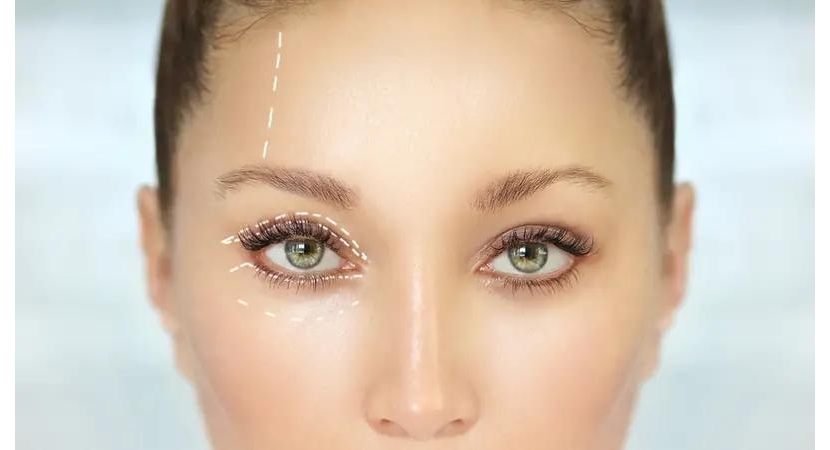
What is Upper Blepharoplasty?
The removal of excess eyelid skin, with or without orbital fat, for functional or cosmetic reasons is now known as blepharoplasty. Upper eyelid blepharoplasty can be performed in the old-fashioned way with stainless steel instruments, radio-surgical incision methods, or laser incision methods. Tissue adhesives are used to close the skin in addition to standard suturing procedures.
During human interaction and communication, the eyes and periorbital area are often the focal point. Age-related changes in the appearance of the eyelids can send the wrong message of fatigue, sadness, and lack of vitality, which can worsen the cosmetic appearance of the face. Pseudoptosis can be caused by dermatochalasis (excess eyelid skin) or steatoblepharon (false hernia of orbital fat tissue) in some situations. The obscuration of the upper visual fields causes symptoms in these patients.
The characteristics of periorbital anatomy are influenced by gender, race, and age. Individuals of different genders and races have different structures around their eyes. When it comes to surgical changes in the periorbita, these specific anatomical relationships are significant.
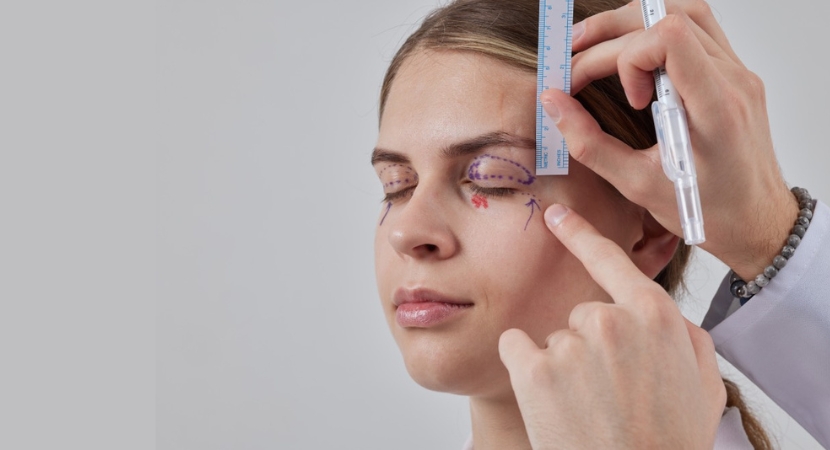
Indications for Upper Blepharoplasty
Upper eyelid blepharoplasty is performed for various purposes, both practical and cosmetic. The eyeball is protected by the upper eyelids, which also distribute tears over the surface of the eye and allow drainage of tears through the lacrimal system. If any of these functions are affected or if significant ptosis of the upper eyelid interferes with vision, the doctor must decide whether surgery is necessary.
The benefits of upper eyelid blepharoplasty include a wider field of vision and improved quality of life, as well as improved vision and reduced headaches. Regarding the effect of the surgery on dry eye and eyebrow height, there have been conflicting results. Upper eyelid blepharoplasty is a cosmetic surgery that enhances the appearance of the eyes. The relationships between the eyebrows, the fat pads under the eyebrows, dermatochalasis of the upper eyelid, or steatoblepharon of the upper eyelid should be considered separately from this treatment.
The patient's motivation and expectations of the outcome are the two most important factors to consider before the surgeon decides to perform cosmetic blepharoplasty. Having well-stated and well-understood surgical goals is the best way to ensure a satisfied patient. Patients who expect secondary benefits from cosmetic surgery, such as improved personal relationships or professional status, are not suitable candidates.
Contraindications for Upper Blepharoplasty
Dry eyes, thyroid disease, ptosis, and coagulation problems are considered relative contraindications. There are varying degrees of dryness in the eyes. When a patient has extremely dry eyes, it is best to advise against blepharoplasty because even a slight increase in corneal exposure can worsen the symptoms. Blepharoplasty can cause lagophthalmos with corneal abnormalities and vision impairment in thyroid orbitopathy with ptosis. Coagulation problems should be treated individually and with the help of a physician. Before considering further blepharoplasty, patients who have had one or more previous blepharoplasties (which are becoming increasingly common) should be carefully evaluated for adequate skin and orbicularis function, as well as for possible lagophthalmos. Finally, there is a subgroup of patients who are photophobic, and blepharoplasty should be avoided in these cases.
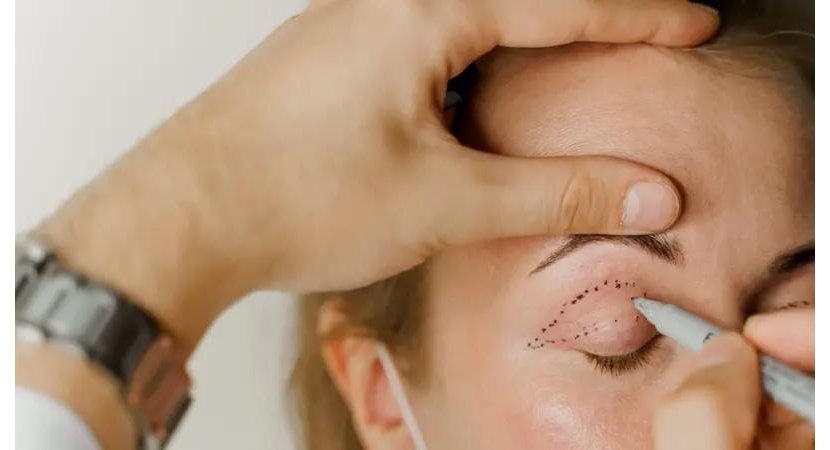
Preparation for Upper Blepharoplasty
Before blepharoplasty, patients may be recommended the following preoperative procedures, which may include the following:
- Quit nicotine and smoking
Smoking and nicotine delay the healing process and prematurely age the skin. When people quit smoking, their cardiovascular activity improves. This can take up to a month, so the sooner you quit smoking, the better.
- Discontinue certain medications
Specific medications and supplements should be discontinued before surgery. These include aspirin, ibuprofen, and vitamin E. Inform your doctor of all medications and supplements you are taking, including prescription and over-the-counter ones.
- Prepare for recovery before surgery
This includes planning time off from work. It's also a good idea to plan ahead for meal times, ask for help with household chores and childcare, and purchase supplies for the recovery period.
Procedure for Upper Blepharoplasty
Skin Marking
The maximum boundary of skin removal and the skin crease is the most important characteristic of marking in blepharoplasty. Any spot that will not be completely eliminated when the patient is prepared can be used for marking. The method of pinching the skin or skin lamella is one of the techniques for marking. The skin pinching procedure is performed with the patient sitting and eyes closed. The lower incision line is determined by the natural palpebral crease. The excess skin is grasped between the jaws of forceps with small forceps. When the eyelid skin is smooth and there is no gap between the eyelids, spots are formed along the creases of the upper eyelid.
Skin lamellae are formed by separating the skin over the entire area of the upper eyelid from the lower orbicularis muscle in the skin lamella procedure. The raised eyelid skin is then applied back onto the orbicularis, leading to skin overlapping. Excess skin is identified and removed.
The main difference between skin marking techniques in functional and cosmetic blepharoplasty is that in functional blepharoplasty, the lateral incision extends beyond the lateral canthal area to accommodate the lateral hood and eyebrow ptosis, whereas in cosmetic blepharoplasty, the lateral incision should not extend beyond the lateral canthal zone.
Anesthesia
Upper blepharoplasty is usually performed under local anesthesia. 2-3 ml of 2% lidocaine with epinephrine is injected subcutaneously over the defined upper eyelid and lateral canthus with a single anesthesia and hemostasis needle.
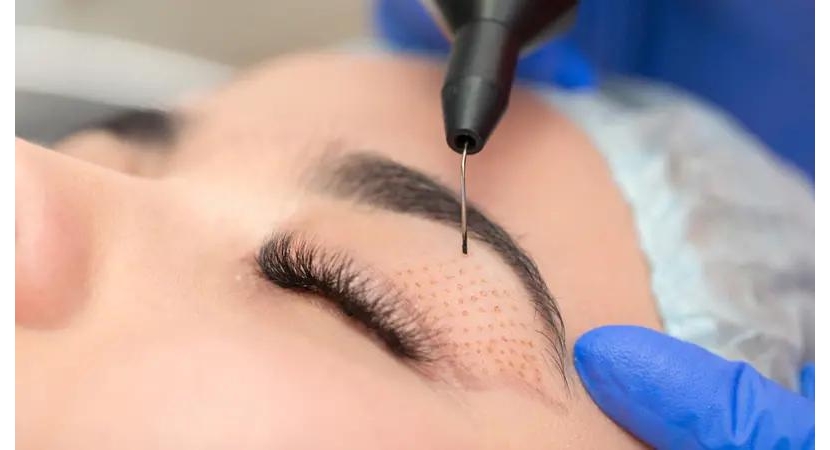
Upper Incision in Blepharoplasty
One side of the wound is lifted, and the skin is removed using a radiofrequency cautery with a fine-angle tip after the skin incisions are made. Small incisions above the septum allow immediate access to the preaponeurotic fat pads when a strip of preseptal orbicularis is removed. The color (embryonic source, the medial fat pad originates from the neural crest) distinguishes the medial (pale) and central (yellow) fat pads, which are gently pulled through the microscopic holes in the orbital septum. When removed with a radiofrequency cautery, the fat pads should either be cut with an electrocautery or held with a hemostatic clamp. Before assisting in its return to the orbit, the residual stump in the hemostatic clamp is cauterized.
Two non-absorbable sutures are used to reposition the retro-orbicularis orbital fat to restore eyebrow volume and internally fixate the target site, i.e., 2-3 mm above the supraorbital margin. To establish a noticeable and desired eyelid crease, interrupted horizontal mattress sutures are passed through the orbicularis oculi muscle, the upper border of the tarsal plate, and the levator fibers. Then, the skin is approximated using non-absorbable sutures, which can be continuous or interrupted.
In older individuals, upper eyelid blepharoplasty is often combined with corrections of eyebrow ptosis, such as internal browpexy, external blepharoplasty, or corrugator myectomy. Browpexy is a suture that connects the eyebrow to the frontal bone beneath it. It can be performed from the inside of the eyelid (internal browpexy) or through a small incision above the eyebrow (external browpexy).
There are several documented surgical procedures for eyebrow lifting:
Direct brow lift: Involves removing supraorbital skin and subcutaneous tissue above the eyebrows, followed by closure of the skin and subcutaneous tissue.
Temporal brow lift: The incision is made behind the temporal hairline, and the dissection plane is above the temporal fascia toward the lateral orbital rim, combined with soft tissue fixation.
Transpalpebral browpexy: The lateral eyebrow is anchored to the anterior periosteum, at a more prominent point, through the upper eyelid crease.
Pretrichial brow lift: A procedure that lifts the eyebrows by making an incision just in front of the hairline. The incision for lifting the center of the forehead is made in the deepest creases of the forehead. The skin and subcutaneous tissue are removed, and the wound is closed without tension.
Coronal brow lift: An open procedure where the skin and subcutaneous tissue are removed several centimeters behind the hairline.
Endoscopic brow lift: Endoscopic brow lift has gained wide recognition as a treatment for rejuvenating youthful eyebrows, as it requires only three barely visible scalp incisions for subperiosteal dissection and final repositioning of the eyebrows.
Postoperative Care
An ophthalmic antibiotic ointment is applied to the incision immediately after surgery. Cold compresses are applied for 48 hours, 20 minutes every hour while awake. For 5 days, the area is cleaned daily, and antibiotic ointment is applied to the incision before sleep. Swelling and bruising are common after this surgery, and cold compresses help reduce this and alleviate patient discomfort. Acetaminophen is usually used, and in some cases, narcotic pain medications may be prescribed. Lifting heavy objects, rapid bending, and intense physical activity are not recommended for two weeks after treatment. You may shower the day after surgery. Normal activities can be resumed after 2-3 weeks.
Follow-up for Upper Blepharoplasty
The patient is examined on the next day after upper blepharoplasty to check for swelling and ensure that the eye is soft and free of bleeding. The wounds are assessed, and the patient is instructed on how to care for them. Patients are encouraged to gently pass through the incision line with a cotton swab soaked in diluted hydrogen peroxide solution to keep the wounds clean and dry. Any additional comments or concerns are addressed at this time. Then, patients are reviewed 5-7 days after surgery to have the stitches removed.
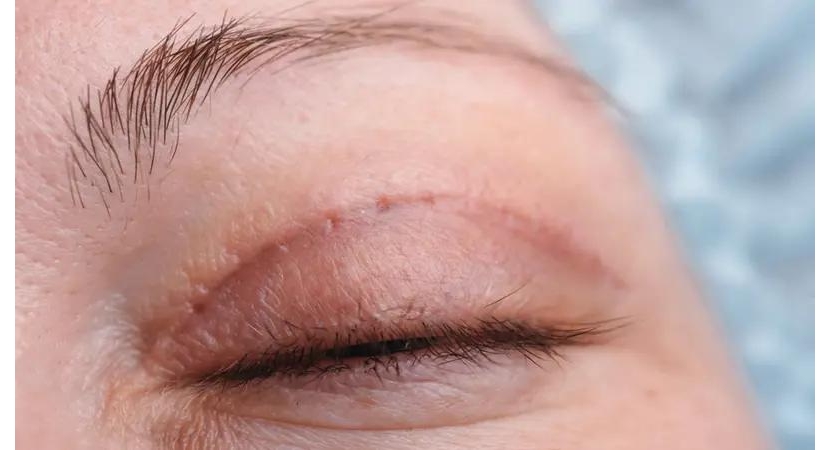
Complications of Upper Blepharoplasty
Cosmetic blepharoplasty is often misconstrued as a quick, painless, and complication-free treatment. While this may be the case with adequate preparation, appropriate physician experience, and careful patient selection, unsatisfactory results and unexpected complications do occur.
Bleeding and infection are two main consequences that rarely happen. Manage hypertension and stop taking medications that make you prone to bleeding to avoid eyelid hematoma and vision loss from retrobulbar hemorrhage. The need for careful and meticulous hemostasis during surgery cannot be overstated. Fortunately, retro-orbital bleeding and vision loss are uncommon outcomes. It is reported that vision loss after blepharoplasty is observed in one out of every 45,000 patients. Following lower eyelid blepharoplasty, retro-orbital bleeding is the most common complication.
Bleeding into the retro-orbital space can lead to acute compartment syndrome, necessitating immediate medical attention. Skin sutures are released, the hematoma is drained, and the incision is re-explored to identify the source of bleeding if active bleeding is evident. Lateral canthotomy and cantholysis may be performed if these treatments do not alleviate compartment syndrome. Exophthalmos and vascular congestion can be treated with intravenous mannitol and steroids to lower intraocular pressure. Orbital decompression may be necessary under specific conditions to reduce orbital pressure.
Due to the high vascularity of the upper eyelids, eyelid infections following blepharoplasty are quite rare. However, when they do occur, they are treated as soon as possible with the necessary antibiotics. The wound is opened and corrected by removing necrotic tissue before closure.
Excruciating pain is unlikely after upper eyelid blepharoplasty. Controlling postoperative pain usually requires mild analgesics without aspirin. If uncontrolled pain persists after blepharoplasty, an examination is conducted as soon as possible to determine the source of the pain.
Excessive skin excision or incisions made in the wrong places can lead to complications. A strip can be obtained if the incision is extended above the medial canthal angle. Noticeable scarring or folds may develop if the incision extends beyond the lateral orbital rim. Excessive removal of skin from the upper eyelid may lead to lagophthalmos with exposure keratitis, ectropion of the upper eyelid, or downward pulling of the eyebrows, exacerbating eyebrow ptosis. This problem can be avoided by carefully measuring the thickness of the skin to be removed before surgery. In the early postoperative period, mild lagophthalmos may develop, which can be corrected with lubricating eye drops and ointment.
Excessive skin resection, scarring on the orbital septum, excessive advancement of the levator, or atypical scarring can cause severe lagophthalmos. A second operation may be required to remove the septal adhesion or place a skin graft to restore the anterior shortening of the upper eyelids.
Blepharoptosis is a rare complication that can develop as a result of inadvertent injury to the levator during surgery. If ptosis persists for more than 6 months, the levator aponeurosis should be monitored and repaired.
Accidental trauma to the upper eyelid muscle during removal of the medial fat pad can lead to extraocular muscle imbalance (diplopia). The upper slanted tendon can be injured by burning and cutting tissue in the medial supraorbital quadrant.
Excessive removal of fat in the upper eyelid causes a depression in the soft tissue above the eyelid fold or a deep upper sulcus. Another problem that can lead to asymmetry or eyelid folds, as well as an unsatisfied patient, is residual excess skin or fat. Asymmetry of the eyelid folds may arise due to inadequate preoperative planning or an inexperienced surgeon altering the position of the folds. When the patient has a previous unilateral ptosis, the asymmetry may become more noticeable after removal of the covering skin folds.
Cost of Upper Blepharoplasty
Some sources provide an average cost for blepharoplasty, but this can be misleading as typical costs do not always cover all fees associated with the surgery. Anesthesia, surgical center fees, medications, and postoperative consumables are common fees. Along with blepharoplasty, a patient's costs reflect other surgeries they may have. It is crucial to weigh the cost of blepharoplasty against the long-term benefits of the treatment. Some people simply need eyelid rejuvenation once and see long-term results.
Upper eyelid surgery is a relatively simple procedure. It takes only 1-2 hours and is performed under local anesthesia. Patients can expect to pay only $1500 for their treatment, with an average cost of around $3200.
Are results from Upper Blepharoplasty permanent?
Patients typically can see the results of their eyelid rejuvenation surgery two weeks after the procedure. The eyes appear younger and more lively as swelling decreases. Although normal aging will continue, long-term effects of blepharoplasty are realistic to expect. After blepharoplasty, wearing sunglasses and gently applying sunscreen around the eyes can help promote healthier and better aging.
Is Upper Blepharoplasty safe?
Blepharoplasty is one of the top five cosmetic surgeries performed in 2018, according to the American Society of Plastic Surgeons. The operation is most common among patients over 55 years of age. While eyelid surgeries are not without risks, most patients recover quickly. The most common side effects of the procedure are bruising and swelling, which usually disappear within two weeks.
Is Upper Blepharoplasty painful?
Local anesthesia, oral or IV sedation, or general anesthesia are all options for blepharoplasty. The type of anesthesia used is determined by the patient's comfort level, overall health, and the presence of additional surgeries such as brow lift, facelift, or rhinoplasty. Local anesthesia and adequate sedation can provide patient comfort. Some patients, on the other hand, prefer to be unconscious during the surgery. During the consultation, doctors help patients choose what will work best for them by discussing the details of each option.
Conclusion
Upper blepharoplasty is an aesthetic and functional surgical treatment that is often performed. However, because the eyelids protect the most important sensory, vision, the surgery must be performed carefully.


